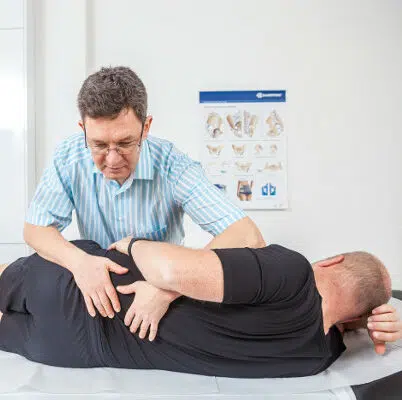Slipped disc - painful change in the spine with far-reaching consequences
Even as an experienced orthopaedist and osteopath, the ingenious inventiveness of evolution never ceases to amaze: for example, the spine is not made up of bony vertebrae alone. Thin, disc-like cartilage is embedded between the individual hard and statically stable elements. And it is these cushioning and buffering intermediate layers, known as intervertebral discs, that make elastic, springy and pain-free movement of the back possible.
A healthy intervertebral disc is divided into a ring-shaped structure of firm fibrous cartilage and a softer, inner gelatinous core. When a disc herniates, the inner gelatinous core loses its original position. It slips, shifts and exerts increased pressure on the outer fibrous ring. This can break through. The mass of the gelatinous nucleus then presses on the nerve tracts or nerve roots that run through it, causing considerable pain and further strain.
A slipped disc does not always cause pain and severe back pain does not always have to be caused by a slipped disc!
Contrary to popular belief, a slipped disc can also cause no or only mild pain in the back. And as orthopaedic and osteopathic practice has shown time and again, the importance of altered intervertebral discs for back pain and back problems is often overestimated. As an orthopaedist and osteopath, I have already encountered numerous patients with pronounced degeneration of the intervertebral discs or even a herniated disc clearly visible on an MRI scan, but whose back pain had completely different causes than the proven herniated disc and could therefore be treated easily and well.
For this reason, it is essential to take a very close look using alternative methods if you have been experiencing back pain for some time. Despite thorough conventional medical diagnostics, the vast majority of back pain cannot be attributed to changes in the intervertebral discs alone.
What counts is a very open-minded approach to diagnostic clarification
In many patients, a slipped disc generally manifests itself with symptoms such as acute pain, sudden immobility, tension, discomfort in the extremities, numbness and even signs of paralysis. However, as such phenomena can always have other causes and triggers, the focus must be on a thorough examination and precise recording of your medical history.
The exclusion of functional disorders of the back and spine is of the utmost importance. Existing problems with the control of posture and movement and, in particular, insufficiently developed deep back muscles, cramped and overloaded muscles or active trigger points can manifest themselves in symptoms that are also characteristic of a slipped disc.
In addition to the examination of the back, including musculature, posture, mobility and neurological status, the diagnostic clarification must also look inwards to the patient's major body organs and psyche. Back pain, back pain and other complaints can sometimes be traced back to internal organs such as the stomach, intestines, gall bladder or uterus. In addition, psycho-social factors must always be taken into account in order to achieve successful treatment.


Book a consultation appointment now!
A quick, simple and easy way to your appointment.
As orthopaedists and osteopaths, we focus holistically right from the diagnosis stage
Our special approach, with its sensible combination of orthopaedic conventional medicine and alternative healing methods, paves the way for us to look at your health situation in the way that is necessary in connection with back pain and a possible slipped disc: we look at things holistically and can gain decisive diagnostic clues from this. For example, lumbar back pain in the lumbar spine, which is often associated with a slipped disc, can result from a functional disorder in this section of the spine in many patients. However, the sacroiliac joints in the pelvic region are also often a possible cause. There may be a combined change with muscular tension or trigger points, which has its cause as a descending chain starting from a disorder of the upper cervical joints in connection with a cranio-mandibular dysfunction CMD; or the disease may occur in an ascending chain, starting from disorders in the area of the tarsals and the ankle joint.
Intervertebral disc surgery - yes or no?
Based on an intensive diagnosis of the individual patient, in which we pay particular attention to holistic connections and causal links in the body, we will only advise you to undergo surgery for a slipped disc if you already have nerve damage and intensive treatment with conservative methods has been unsuccessful.
If the need for surgery can be ruled out on the basis of a thorough neurological examination, we will take care of you as part of a comprehensively planned and structured therapy:
-
Mobilising manual therapy techniques and osteopathic methods are used to focus on harmonising and eliminating functional disorders.
-
As with the general treatment of back complaints, I can also use osteopathy and other alternative medical procedures to uncover other functional disorders and resolve muscular or fascial interlinkages during your disc treatment in our orthopaedic practice.
-
Our treatment also focuses on eliminating muscular imbalances and existing trigger points.
-
Intensive physiotherapy can make a valuable contribution here and, once the acute phase has subsided, we can switch to targeted training therapy to stabilise the muscles.

